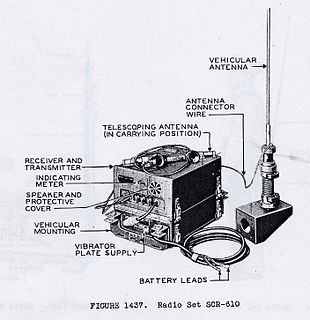Related Research Articles

Signal Corps Radios were U.S. Army military communications components that comprised "sets". Under the Army Nomenclature System, the abbreviation SCR initially designated "Set, Complete Radio", but was later misinterpreted as "Signal Corps Radio."
The SCR-197 was a ground mobile high frequency radio station used by the U.S. Army Signal Corps prior to and during World War II, notably the Battle of Wake Island in 1941.

The SCR-694 was a portable two way radio set used by the U.S. military during World War II.
The K-38 splicer's trailer was used in World War II for carrying telephone cable splicers tools in the field.

The SCR-277 was a mobile, trailer mounted radio range set for radio guidance of aircraft. It was standardized by the U.S. Army in June 1941.
The K-37 trailer was used by the U.S. Army Signal Corps to haul telephone poles, and Cable reel, during and after World War II.

The Jeep trailer was a small, 1⁄4 short ton payload rated, cargo trailer, designed in World War II, tailored to be towed by 1/4-ton U.S. Army jeeps. Versions of the quarter-ton jeep trailer remained in military use, by the U.S. or other countries, at least through to the 1990s.

Ben Hur trailer was the nickname of the World War II U.S. Army Trailer, 1-ton payload, 2-wheel, cargo, and the Trailer, 1-ton payload, 2-wheel, water tank, 250 gallon. Specialized variants were also manufactured.

The K-36 trailer was a telephone pole hauling trailer used by the U.S. Army during and after World War II.
The K-34 trailer was used by the U.S. Army Signal Corps to house electronic equipment, during and after World War II.
The K-55 trailer, manufactured by the A. J. Miller and Oneonta Linn Corp, was a house trailer used by the U.S. Army Signal Corps during and after World War II.
The K-72 trailer, manufactured by the A. J. Miller, was a house trailer used by the U.S. Army Signal Corps during and after World War II.

The K-50 telephone repair trucks were used by the U.S. Army Signal Corps, during and after World War II, for the installation and repair of hard telephone lines, primarily in territories liberated from Nazi Germany by the Allied forces.
The radio set AN/CRN-2 was an air transportable glide path transmitter used by the Army Air Force during and after World War II, the set was standardized on 5 February 1944. and was an upgrade of SCR-592.
The AN/MRN-1 was an instrument approach localizer used by the Army Air Force during and after World War II. It was standardized on 3 July 1942. It replaced the SCR-241, and was a component of SCS-51.
The AN/MRN-3 was a marker beacon set used by the Army Air Force during and after World War II, it was standardized 23 October 1943, and replaced SCR-241.

The SCR-610 was a Signal Corps Radio used by the U.S. Army during and after World War II, for short range ground communications, it was standardized 29 Sept. 1941,

The AN/MRN-2 was a Radio Range set used by the Army Air Force during and after World War II, it replaced in part the SCR-277.

The Autocar Model U8144T, officially "5- to 6-Ton, 4×4, Ponton Tractor Truck", was the largest, and most heavy-duty, of a family of heavy four-wheel drive trucks developed for, and deployed primarily with, the United States Army in World War II. They were of a "cab over engine" design, and produced by the Autocar Company from 1941 to 1945 with 2,711 being built.
References
- TM 9-2800 Standard Military Motor Vehicles. dated 1 sept. 1943
- TM 9-2800 Military vehicles dated Oct. 1947: https://www.scribd.com/doc/188375301/TM-9-2800-1947
- TM 11-227 Signal Communication Directory. dated 10 April 1944
- TM 11-487 Electrical Communication systems Equipment. dated 2 Oct. 1944